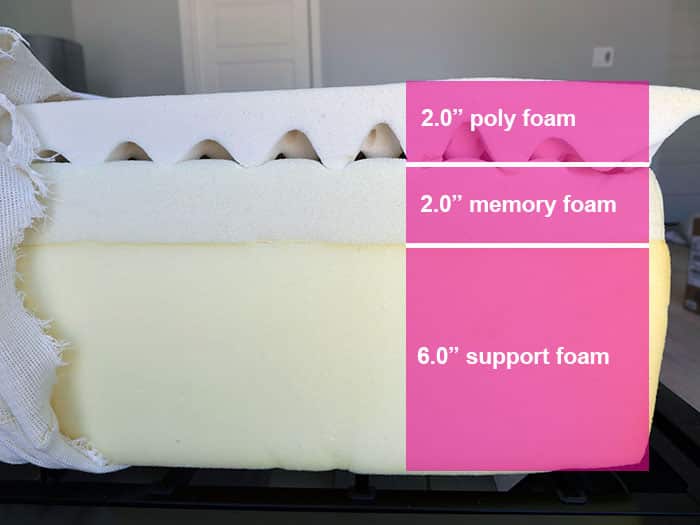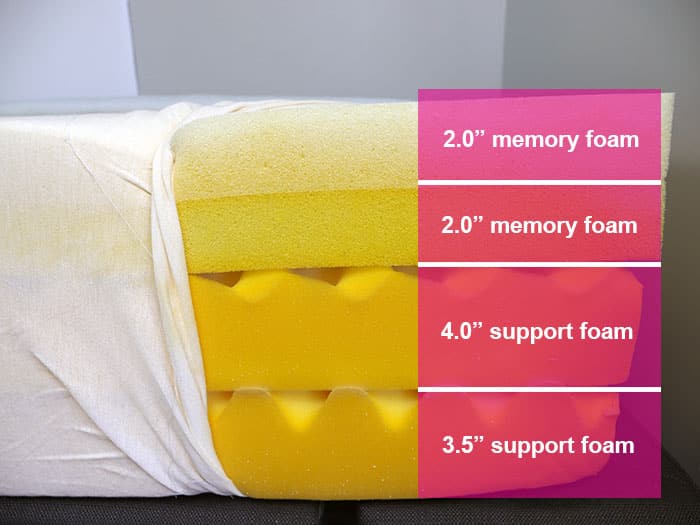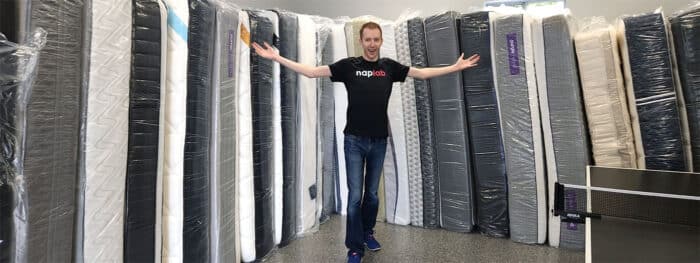Finding the right mattress isn’t easy. You could spend days or weeks shopping around for one that meets your needs. Luckily, quality mattresses are resistant to wear and tear, so you won’t need to replace your new purchase anytime soon.
So, how do mattresses last? It depends on the model, foam density, and materials used, among other factors. Generally, the standard lifespan of a mattress is around 8-12 years. The highest quality models can last for up to 15 years.

However, these numbers are not set in stone. Below we’ll discuss the factors that may affect the lifespan of a mattress and how to choose a product that’s not just comfortable, but also durable.
How long do mattresses last on average?
A quality mattress offers proper support and gets even more comfortable over time. Its lifespan, though, depends on a variety of factors, including your body weight and the time spent in bed.
Leaving these aspects aside, you can expect your new mattress to last anywhere between 8-12 years.
Sure, you may continue to use it much longer than that, but it won’t provide the same level of comfort and support as a new model.
Insider reports that mattresses last for seven to 10 years and may start to break down after nine years of use. Again, these numbers vary among brands and models.
Mattresses made from natural latex, for example, are more durable than memory foam and innerspring mattresses. Some models can last for up to 15 years.
This brings us to the next point…
How can you tell when you need a new mattress?
Knowing when to replace a mattress can be a tricky task. And there are a lot of factors that can affect the overall length of time that a mattress can last.
Can a mattress last 20 years?
Some manufacturers say that their mattresses can last for up to 20 years. That’s possible, assuming that you only use the mattress occasionally.
If, say, you have a vacation home and sleep there once a year or so, your mattress will last longer than the one you use at home, nightly.
Can a mattress last 10 years?
Generally, pillow-top mattresses have a lifespan of 5-6 years, while those made from natural latex can last up to 15 years.
However, most mattresses including foam, spring, and memory foam will last 8-12 years.
Factors that Affect Mattress Lifespan
Let’s see other factors that affect the lifespan of a mattress:
#1. Usage
The more you use your mattress, the shorter its lifespan. Consider getting a mattress protector to prevent spills and stains.
#2. Mattress Care
Dust, debris, stains, and bacteria can all affect the lifespan of your mattress. Rhea Mehta, Ph.D. recommends vacuuming your mattress each time you change the sheets and giving it a deep cleaning once or twice a year. See our guide on how to clean your mattress to find out more.
If you have a two-sided model, flip it every six to 12 months to reduce wear and wear on one side. Likewise, you should rotate the mattress every six to 12 months. In both cases, you should follow the instructions provided by your mattress brand.
#3. Foam Density
Mattress foam density is measured in pounds per cubic foot (PCF). If you want a durable mattress, choose one with a PCF of at least 1.8, with 2.0 PCF or higher being ideal.

Anything below 1.8 PCF indicates a low-quality foam that won’t last too long. Lower PCF foams are only acceptable as a comfort foam-up top, and not as support or other core layers.
#4. Number of Coil Layers
In general, the higher the number of coil layers, the longer a mattress will last. Innerspring mattresses with a coil-on-coil pattern are more durable and offer better support than those having a single layer of coils.

#5. Type of Coil
Generally, mattresses with continuous coils or Marshall (pocketed) coils have a longer lifespan than those with Bonnell coils, the most widely used design.
#6. Coil Gauge
Coil gauge, or the thickness of the wires used to build the coil, may affect the longevity of a mattress.
A lower coil gauge count indicates a thicker and more durable wire.
Mattresses with thick coils are stronger and more durable than those with higher coil gauge counts. A coil gauge of 12-13 is thicker and more durable than a higher gauge. However, it’s also a firmer coil.
A higher gauge coil, say a 14-16, has a thinner winner, is less firm, and also less durable over time.
Most mattresses have a coil gauge of 12-16.
#7. Type of Mattress
As mentioned earlier, classic pillow-top mattresses only last for five to six years. In general, a pillow top will develop indents more quickly compared to other types of mattresses.

#8. Your Body Weight
As Dr. Jonathan S. Kirschner told Insider, your mattress will wear out faster than normal if you’re placing 250 pounds or more on it. If you’re on the heavier side, you may need to replace the mattress more often compared to a lighter person.
Consider buying a latex mattress, one with higher foam density, or a spring mattress with coil-on-coil design and heavier gauge coils. These models are more suitable for heavy users and can withstand wear and tear better than those made from other materials.

If you choose a mattress with low weight capacity, it may begin to sag and cause discomfort sooner.
#9. Mattress Quality
A high-quality mattress will last longer than a cheap one. However, this doesn’t mean you should spend thousands on a new mattress.
Some sellers charge more because of the brand name.
Plus, mattresses sold in physical stores often come with a higher price tag than those available online.
Check out our guide to see how much you can expect to pay for a brand new mattress.
#10. Sleep Position
Whether you’re a back sleeper, side sleeper, or stomach sleeper, you probably use certain areas of the mattress more often than others. Over time, those spots can wear out because of the increased pressure.
One way to reduce wear and tear is to change your sleep position regularly.

For example, if you’re a side-sleeper, try to rest on your back every now and then so that the mattress surface compresses evenly.
How often should you replace your mattress?
While the standard lifespan of a mattress is 8-12 years, some models last longer than others. Since these products don’t have an expiration date, it’s up to you to decide when you should replace your old mattress.
Most times, you’ll know when it’s time to buy a new mattress.
For example, you may wake up tired for no obvious reason or have back pain in the morning.
Some people also experience neck pain, aching joints, or overall discomfort when sleeping on an old mattress.
What happens to an old mattress after 10 years?
Here are other signs that your old mattress may need to be replaced:
- Permanent indentations—Sooner or later, you may notice permanent indentations in the foam material. This could be a visible dip where you normally sleep or under the pillow. If that dip exceeds 2″, then it’s probably time to replace your mattress.
- Tears or rips—These signs of wear and tear can affect the level of comfort and support provided by a mattress. The larger they get, the more discomfort you’ll experience.
- Sagging—A sagging mattress can no longer offer proper support for your spine and muscles. As a result, you may wake up with body aches and stiffness in your neck or back. Over time, sleeping on a sagging mattress can affect the alignment of your spine, warns Kirschner.
- Noisy springs—If your mattress is squeaking when you sleep on it, then it’s time to buy a new one. Those annoying sounds are often a sign of broken coils or springs and can affect your sleep.
- Excessive softening—Mattresses tend to become less firm over the years. When that happens, they may no longer offer optimal support for your spine and body.
- Persistent stains and smells—A mattress that’s severely stained or has foul odors can be a health hazard. Excessive moisture from sweat, urine, or spills promotes bacteria and mold growth, leading to poor health.

How do you fix a sunken mattress?
One of the biggest complaints about old mattresses is a sunken surface that comes from coil damage or foam compression.
To remedy this you can try adding a mattress topper. While this may add softness or comfort, it won’t really solve the underlying support issue that comes from a sunken mattress.
The only way to really fix this is to replace the mattress.
Can an old mattress make you sick?
Not only can an old mattress hurt your back and leave you waking with aches or pains, but it can affect your body in other ways also.

Here are some of the ways your old mattress may be hurting your body:
- Worsening allergies or asthma—A seven-year-old mattress can have up to five times more bacteria, including hazardous strains like E. coli and Staphylococcus aureus, than a one-year-old one.
DID YOU KNOW? Worn-out mattresses may also carry dust mites, bed bugs, mold, and other pathogens. These microorganisms can trigger allergic reactions, breathing problems, and asthma flare-ups.
- Tossing and turning at night—If you find yourself tossing and turning during sleep, your mattress may not offer adequate support. Even if it’s in good condition, it might be worth buying a new one.
Why do mattresses get heavy?
If you’ve been using the same mattress for eight to 12 years, it’s probably time to buy a new one. It may no longer support your spine as it should and that’s not the only concern.
DID YOU KNOW? According to a study, humans produce 26 gallons of sweat per year while sleeping. That’s a lot of liquid being absorbed by your mattress.
The University of Manchester
An old mattress can become a breeding ground for bacteria, yeast, dust mites, and allergens.

You may also need a new mattress if you’re putting more weight on it. For example, if you’re now sharing the bed with someone else, your old mattress may not accommodate the extra weight.
Final Thoughts
Now that we’ve answered your question, “How long do mattresses last,” it’s time to decide whether or not you need a new mattress. Check the one you have at home and consider your health needs before making the switch.
With proper care, a high-quality mattress can last for eight years or longer. Like with most products, you get what you pay for.
Assess your needs, set a budget, and go online to see your options.

Custom Mattress Recommendation
So you need a new mattress, but are not sure where to start? Let the NapLab team help you with a free custom mattress recommendation.
Click here to answer a couple of quick questions about yourself and your sleeping style and we will send you a custom recommendation.
FAQ
Most mattresses last between 8-12 years. The exact lifespan can vary depending on mattress type and material quality. Assess how well you are sleeping on a regular basis. This approach can help you determine when it is time for a new mattress.
While many mattresses do offer lifetime warranties, after 20 years it’s probably time to go shopping. Even if the mattress were still supportive after 20 years—that is still 20 years of dust mites, dirt, sweat, body fluids, possibly pet dander, and the obvious effects of any accidents over the years.
If your mattress is worn out, you may find yourself waking up with pain you usually didn’t wake up with. Night wakings, stiffness, tossing and turning, etc are all signs that you’re not getting your best sleep. This could mean your mattress is worn out and unable to provide adequate support.





